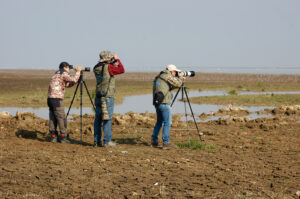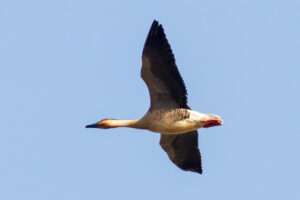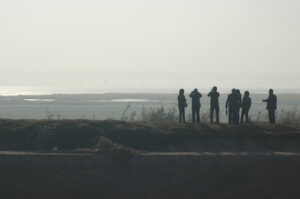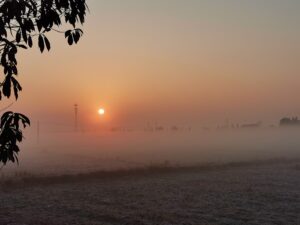
BIRDING LAKE POYANG IN DECEMBER 2019, A MEMORABLE EVENT
 Poyang Lake International Birdwatching Week, December 2019
Poyang Lake International Birdwatching Week, December 2019
One of the most amazing trips I did during my two and a half years in China was to Poyang Hu, a huge lake in Jiangxi Province that is known to birdwatchers around the world as the last wintering ground of the beautiful but critically endangered Siberian Crane, which migrates from its nesting grounds in northern Russia to spend the winter there, providing a spectacular sight with its pure white plumage, contrasting with jet black wing tips and a fiery red bill and forehead. Other endangered birds occur around this huge lake too, notably the Swan Goose and the Oriental White Stork. Even just the thought of seeing substantial numbers of these and other wintering bird species is enough to set any birder’s heart racing! Reaching the lake without local help is difficult for foreigners, but such difficulties did not trouble us, because my Shanghai-based British birdwatching friend Paul Hyde and I had the immense privilege of being invited as guests of the Jiangxi government to participate in a major international event that brought conservationists from several countries that host the birds that over-winter at Poyang, notably Russia, India, and several south-east Asian countries, as well as experts from the UK and Australia, to see at first hand the efforts being made to preserve the natural habitats around the lake. Although Paul and I were not free to attend the whole of the week-long conference due to work commitments, we were able to participate in the weekend programme, which involved a bird race between no fewer than 30 teams, each made up of some Chinese and some foreign members. The aim was for each team to compete to see which one could spot the largest number of bird species within a 24-hour period. I arrived by train at Nanchang station on the Friday afternoon following a four-hour journey from Suzhou on one of China’s amazing super-fast bullet high speed trains, and was picked up by a team of enthusiastic student volunteers, and was then driven to the immense Jiangxi Government Guest House, which was more like a luxury 5-star hotel complex than a guest house. Here I attended the evening event, which featured crane-themed dances and songs, as well as speeches and film shows, and provided an opportunity to network with other conservationists from around the world. I particularly enjoyed getting to know some experts from the Ramsar Convention and the UK-based Wildfowl and Wetlands Trust (WWT), who are collaborating with their Chinese counterparts to protect such threatened waterfowl as the Scaly-sided Merganser and Baer’s Pochard.
 The evening event included crane-themed dances and music
The evening event included crane-themed dances and music
 The Jiangxi government had organised a wonderful show
The Jiangxi government had organised a wonderful show
The Saturday morning was supposed to see the bird race begin bright and early, but due to the inevitable delays associated with mustering the thirty teams and directing them to the correct vehicles, it was eleven o’clock by the time we were finally ready to depart. The car park was an impressive sight, with thirty large 4WD vehicles lined up, each with a driver and each flying a Chinese flag. Our team, comprising Chinese birder Luyuan Ge, local driver and guide Tang Jiemo, Paul and myself, was one of the first to be ready, and we set off in convoy on the journey to the lake, but to our secret delight, we lost the rest of the teams suddenly and found ourselves reaching the lake area completely alone. This made birding much more pleasant and we soon started ticking off birds.
 Lake Poyang features vast open vistas across grassland and water
Lake Poyang features vast open vistas across grassland and water
Our first stop was at a roadside location overlooking a large area of low grass and sedge, but apart from large numbers of geese flying in the far distance, we did not see much here so we moved on to another open area close to the water, where it was decided that we would eat our picnic lunch, although Paul and I were actually rather keener on finding some birds than bothering with such a trivial matter as eating – a cultural difference between the Brits and the Chinese, perhaps!
 Looking out from our lunch place, but the birds were distant
Looking out from our lunch place, but the birds were distant
There were birds visible from here, but they were extremely distant and lost in heat haze (even in December it was still pretty warm). We did manage to see a number of Bewick’s and five Whooper Swans; the second of these two species turned out to be a useful sighting for our bird race list as nobody else recorded it during the two day event.
 The distant white birds were lost in the heat haze
The distant white birds were lost in the heat haze
But far more impressive than the swans were some much taller white birds, the almost mythical Siberian Cranes. Although we couldn’t see the birds on the ground well, we were treated to several groups of flying cranes, their black wing tips contrasting beautifully with the pure white plumage of the adult birds and the blue sky behind. There were a number of young birds too, which was pleasing to see as the world population of this splendid bird may not exceed 4000 individuals. To see large groups of Siberian Cranes was especially poignant for me as I had had the sad honour to see the last family of three of these birds that wintered at Bharatpur in India in 1988, the last individuals of the western population of Siberian Cranes that eventually fell victim to trigger-happy gunmen on their perilous migration route across Afghanistan and Pakistan.
 The Siberian Cranes looked majestic against the vivid blue sky.
The Siberian Cranes looked majestic against the vivid blue sky.
After lunch, we drove on into the Lake Poyang Nanji Wetlands National Nature Reserve, and spent the afternoon checking each spot along the road here, adding bird after bird to our list, including around 50 Swan Geese (a life bird for me), more than 100 Greater White-fronted Geese, 10+ each of Tundra and Taiga Bean Geese, 200 Siberian, 30 Common and 9 Hooded Cranes, 150 or more Pied Avocets, more than 200 Oriental White Storks (another critically endangered species), one Great Bittern that gave an outstanding view close to the road, 200 or so Eurasian Spoonbills, 2 Pied Kingfishers, one Chinese Grey Shrike, and at least 8 Oriental Skylarks. We also visited a high tower near a village, from where we were treated to an excellent view of a circling Crested Serpent Eagle, not a bird I had expected to see here in winter. By the end of the day, our list had reached 71 species, which we were fairly satisfied with, although we had no idea of how the other teams were faring.
 Swan Goose was a lifer for me. Photo by Paul Hyde
Swan Goose was a lifer for me. Photo by Paul Hyde
 Oriental White Stork was another star bird. Photo by Paul Hyde
Oriental White Stork was another star bird. Photo by Paul Hyde
 Crested Serpent Eagle was not a bird I had expected. Photo by Paul Hyde
Crested Serpent Eagle was not a bird I had expected. Photo by Paul Hyde
 This Great Bittern put on a fine show. Photo by Paul Hyde
This Great Bittern put on a fine show. Photo by Paul Hyde
The following morning we were able to start early, which we needed to do as the 24 hours of the bird race would end at 11AM. The drive to the lake in the dawn was atmospheric, with mist rising from the fields, and we were in position by 8.00. Our chosen location for this morning was intentionally different because we hoped to add some woodland birds to what on the previous day had been very much open country and lake-type habitats. We parked near a series of flooded former quarries with dramatic cliffs around them, and winding wooded trails which we scoured for birds to add to our list.
 Our first location the next morning was this magical spot
Our first location the next morning was this magical spot
 Looking like an ancient Chinese painting, these pools were our first birding location that day
Looking like an ancient Chinese painting, these pools were our first birding location that day
At first the conditions were misty, and the wooded bluffs rising out of the mist above the lakes was like something out of an ancient Chinese painting. We soon began to notice lumps in some of the trees overhanging the water, and closer inspection revealed them to be at least 200 roosting Black-crowned Night Herons, an impressive sight. Other woodland species began to appear, and we managed to add some very nice birds to our list, including Scarlet Minivet, Collared Finchbill, Black-throated Tit, several warbler species, Grey-backed and Dusky Thrushes, Yellow-billed Grosbeak and Chestnut Bulbul, among others.
 Large numbers of Night Herons roost here
Large numbers of Night Herons roost here
 Poyang Lake is a magical place to watch birds
Poyang Lake is a magical place to watch birds
A walk around a more open village area revealed a Black-capped Kingfisher posing on top of a bush, as well as Little and Black-faced Buntings near a rubbish dump. Ring-necked Pheasant also showed here, while overhead constant streams of geese and cranes could also be seen flying over.
 Paul birding by the rubbish tip!
Paul birding by the rubbish tip!
By now the clock was ticking, and we headed back to do some final water-bird watching, and what a good thing it was that we made that choice, because we found ourselves looking at two Baer’s Pochard, one of China’s most rapidly declining birds, just as the clock approached the deadline of 11AM. We posted the information in the group chat, and it was not long before other vehicles arrived, but after the event had ended!
 Our team: Paul Hyde, self, Tang Jiemo and Luyuan Ge
Our team: Paul Hyde, self, Tang Jiemo and Luyuan Ge
It took us a few moments to tot up our tally, and finally we knew that our total was 92 species for the 24-hour race period. But what scores had the other teams achieved? We would not find out until later. The teams congregated at a nature reserve building, where we also made two more interesting sightings, both in some ways connected with birds! The first was a genuine bird, a Eurasian Wryneck that posed briefly on the roof of the building, and second, none other than John MacKinnon, renowned author of the standard work “A Field Guide to the Birds of China”, a must-have in every birder’s library. We couldn’t exactly add him to our list, but it was a pleasure to meet him anyway! [caption id="attachment_8376" align="aligncenter" width="300"]
 Spotting John MacKinnon was an added bonus!
Spotting John MacKinnon was an added bonus!
After all the teams had submitted their lists, together with photos or descriptions of any unusual birds, the scores were announced, and to our considerable delight, we came second! They may have misinterpreted the rules, which stated that the members of each team must remain together, but we had witnessed the team that did win, with 96, splitting up to cover more ground. But even with that in the back of our minds, it was a pleasure and a matter of some pride to know that we had so nearly won!
 Our prize being awarded, but Paul and I had already had to leave!
Our prize being awarded, but Paul and I had already had to leave!
Sadly, Paul and I both then had to leave, as our trains back to Shanghai and Suzhou were due to depart mid-afternoon from Nanchang station, so we missed the prize-giving and closing ceremony, and we were unable to receive our runners-up award, a pair of BOSMA 8X42 binoculars. Luckily, our team members kindly arranged to have them sent to us, and we set off on our journey, very happy after an excellent weekend. Paul’s binoculars arrived very quickly, but mine disappeared due to confusion about my address, but luckily I had already met the BOSMA representative, Chi HongJi, on the Friday evening, and established WeChat contact with him, so I was able to contact him, and he offered to send me another pair, but of a different, 9X32 model, on condition that I write a review of it. Once the binoculars had arrived, I tested them and found them to be an absolute delight, very light to carry but with an excellent image quality….and then, a few days later, the original pair arrived, so I ended up with two pairs of BOSMA binoculars, as well as an excellent sleeveless jacket with the logo of this wonderful weekend embroidered on the back. I still wear that jacket today, and it arouses plenty of curiosity (and perhaps envy), as few westerners have had the privilege of visiting the magical Poyang Hu, let alone as guests of the Jiangxi provincial government. Thank you to all concerned!
 Swan Geese winging their way over Poyang
Swan Geese winging their way over Poyang




